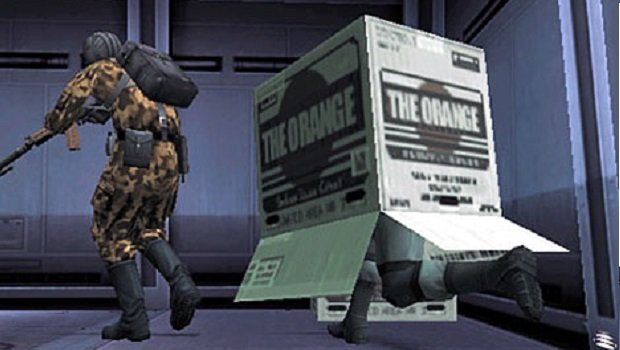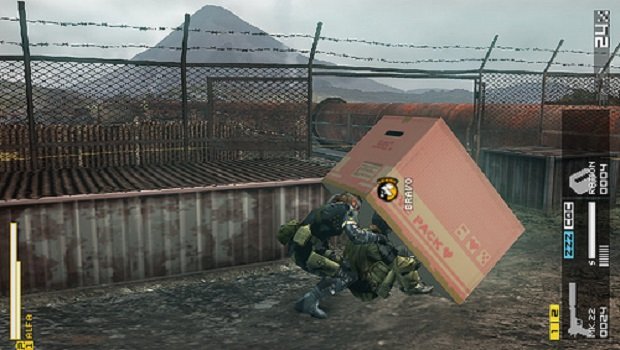Why I Love: Metal Gear Solid's cardboard box
Metal Gear Solid is very serious business, except for when it's not. The series has deftly straddled the line between the solemn and the goofy, the mundane and the fantastical, ever since its inception in 1987. I can't think of too many games that can feature a scene requiring you to point a directional mic at two villains as they discuss their successful abduction of a US president… which you can completely ignore to listen to an unfortunate man attempt to evacuate his bowels in a nearby restroom. The series swings wildly between the absurd and the somber, often within the same scene, and it's done so naturally that it's hard to think of Metal Gear as anything but a combination of the two. There's no item in Snake's repertoire more representative of this perfect balance between the equally important halves that make up Metal Gear's tone than his constant corrugated companion, the cardboard box.

The cardboard box made its first appearance in Metal Gear on the MSX as a way for Solid Snake to evade enemy patrols and surveillance cameras. If you wear it in the back of a handful of specific trucks, the enemy soldiers will even transport you around Outer Heaven. Of course, the game doesn't tell you any of this, as you have to figure out its myriad uses for yourself. The first time you equip it and notice your avatar's been replaced with a box, your mind begins swimming, awash in all the stealthy possibilities.
Much like the series itself, the cardboard box has been overhauled numerous times over the years, showing just as much technical sophistication as Snake's night vision goggles or his upgraded Nikita missile launcher. Metal Gear Solid brought the cardboard cube into three-dimensions, showing a Solid Snake fully embracing his inner five-year-old, as he darts from cover to cover with his legs hilariously poking out of the bottom of the box. If Snake is careful (and a little lucky), guards will stop to take a look at this seemingly out-of-place delivery crate, then walk on by, dismissing it completely. "Just a box," they reason, continuing on their patrol. If only they knew the truth.
Further entries give Snake a variety of boxes to play with. In Metal Gear Solid 2, Snake finds a wet box for hiding outside in the rain on the deck of a massive oil tanker, and Raiden stumbles across a box with the Zone of the Enders logo on it (the hottest video game franchise in America, don'tcha know?) purely for kicks. And in MGS 5, it appears to be a veritable mobile stealth fortress, allowing Snake to pop out and surprise guards, use it as a sled to ride down hills, or leap out the side for a quick escape.

Kojima and crew constantly devote so much care and attention to such a seemingly throwaway item. Cardboard boxes are, by nature, disposable - put stuff in it, and recycle it when you're done. But in Metal Gear, the box is just as important as any weapon you find on the field. It's ridiculously versatile, allowing you to create an effective hiding place anywhere you are (as long as you're careful), and its silliness is always juxtaposed against a larger threat. Terrorists have taken over something or other, they're armed to the teeth with assault rifles and grenades, you're literally one mistake away from a nuclear holocaust - and yet, here you are, sneaking past highly trained infantry in a box designed to ship fruit.
The best part is that, in the world of Metal Gear Solid, the cardboard box isn't just a completely legitimate stealth strategy; its characters often recognize it as such, and encourage Snake to make good use of it. These are hardened soldiers, trained to be the best of the best, but they recognize the value of a good set of camouflage when they see it. Raiden appears unconvinced on the merits of walking around wearing a box, until Lieutenant JG Iroquois Pliskin (aka Solid Snake in obvious disguise) espouses its benefits at great length.

And it's not just Solid Snake who's a fan. This fondness for the cardboard box goes back an entire generation, as Naked Snake discovers the warm, comforting embrace that comes from his newly discovered safe haven in MGS3. When Snake creates Mother Base off the coast of Latin America in the mid-1970's, everyone is 100% on board with Kaz Miller's requested improvements, thanks to "recent developments in cardboard box technology". The people who find it silly that a grown man is running around the battlefield with a box on his head? They're regarded as the strange ones, close-minded in their approach to tactical espionage operations.
Weekly digests, tales from the communities you love, and more
The cardboard box is there as a constant reminder that, when you play Metal Gear, you're effectively involving yourself in a complex game of toy soldiers. It's easy to get wrapped up in the convoluted narrative, to start taking everything a bit too seriously - and there are certainly themes that Metal Gear Solid does want you contemplate on a bit more deeply than many other games try to do. But in the end, Metal Gear Solid is still very much a video game, one that lets you scroll through an assortment of realistic weapons, gadgets, and other implements of pain and destruction, to finally stop on a simple, elegant, almost childish way to avoid all this unnecessary bloodshed.



